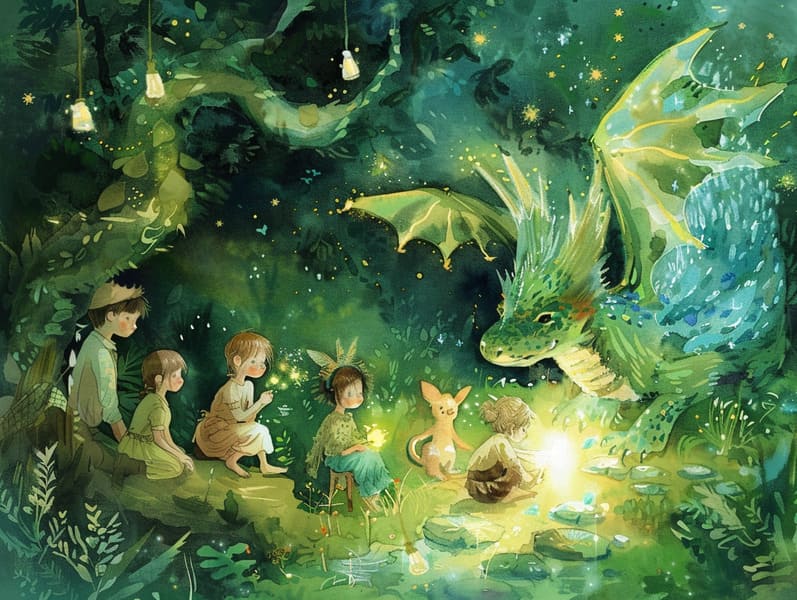The Creation of Children's Fairy Tales and Their Everlasting Grace.
The Creation of Children's Fairy Tales and Their Everlasting Grace.
Blog Article

Fairy tales have timeless appeal. These tales have been relayed from one generation to the next far before they were ever recorded. They developed from a variety of cultures, including Indigenous traditions. They were initially passed along among elders, often carrying themes and messages relevant to the societal norms and beliefs of the time.
The Grimm brothers, Jacob and Wilhelm Grimm, were among the first to collect and release many of these beloved fairy tales. Their collection, "Grimm's Children's Stories," included classics like "The True Bride," "The Story of Hansel and Gretel," and "Little Snow White," which have since become cornerstones in the world of beloved fairy tales. Similarly, Andersen's fanciful fairy tales, such as "The Little Mermaid," and "The Story of the Ugly Duckling," have enchanted hearts worldwide, cementing their place in the pantheon of classic fairy tales.
Though they are old, classic fairy tales remain as important as ever, especially as nighttime stories for kids. These whimsical stories are now available in diverse formats, including gorgeously illustrated books, magical animations, and digital storybooks.
Their continued relevance can be linked to several delightful features:
Crucial Morals: Classic fairy tales often illustrate important moral lessons. Tales like "The Tale of the Boy Who Cried Wolf" teach the benefit of sincerity, while "The Story of the Tortoise and the Hare" exemplify the traits of determination and unassuming nature. These narratives offer young readers clear distinctions between moral and immoral, shaping their moral compass in a subtle yet important way.
Sympathy and Perception: Fairy tales frequently involve heroes facing tests and troubles, motivating audiences to understand with their struggles and root for their triumphs. For instance, "The Tale of Beauty and the Beast" reveals the virtue of seeing beyond looks to acknowledge the inner spirit of a individual, promoting warmth and appreciation.
Cultural Knowledge: Many timeless fairy tales are deeply embedded in the cultural contexts from which they grew. Reading these stories can provide informative snapshots into different heritages, fostering a sense of global appreciation and perception.
Inventiveness and Fantasy: The fantastical elements in traditional fairy tales—enchanted forests—invigorate children’s creative dreams. These stories bring readers to supernatural realms, enlivening innovative thinking and a sense of astonishment that endures a lifetime.
Traditional fairy tales are not only charming but also didactic. They work as bewitching tools in developing various brain and heart skills in kids. When fairy tales are voiced, they improve verbal skills by showing new linguistic elements and detailed sentence structures. This practice also enhances hearing abilities and attentiveness, as the young listen intently, excited to see what happens next.
Furthermore, contemplating the themes and characters of timeless fairy tales can nurture problem-solving abilities and logical thinking. Children are led to discover patterns, make predictions, and catch on to cause and effect. These conversations also boost children utter their thoughts and feelings, adding to their emotional intelligence.
In today’s high-tech era, the existence of digital fairy tales has made these fairy tales more accessible than ever. Online resources and web apps share comprehensive collections of bedtime fairy tales that can be seen or heard anytime, anywhere. Fairy tales told out loud are particularly favored, presenting an fun way for the young to be a part of these charming stories. Read-aloud stories and read-out-loud videos transport characters and settings to life, often enhanced by enchanting sound effects and melodies that amplify the tale read more experience.
The timeless fascination of traditional fairy tales lies in their ability to adapt to current times while preserving their basic principles. Contemporary reinterpretations of these stories often spotlight more different figures and modern settings, making them pertinent to today’s audience. However, the core values of guts, kindheartedness, and rightness remain unchanged, continuing to influence young readers of all ages.
Timeless fairy tales also offer a sense of serenity and knowability. They afford a systematic narrative with a apparent beginning, middle, and end, often concluding with the finalization of conflicts and the triumph of rightness over wrongness. This dependability can be encouraging for kids, granting a sense of reliability in an shifting world.
Old fairy tales continue to delight and enlighten new generations, maintaining their delight and value in modern society. As bedtime stories for kids, they extend a perfect blend of charm and understanding, enriching moral values, empathy, and creativity. The availability of digital storybooks and the favor of fairy tales voiced promise that these ancient stories remain obtainable to new generations.
By conserving and disseminating these stories, we continue to honor the rich tapestry of fantasy and cultural heritage. Whether you are browsing a artistically illustrated book, perusing a virtual library, or playing an read-aloud book, the radiance of traditional fairy tales is always within reach. These narratives highlight of the unceasing magic of tales and its ability to connect us across eras and regions.
Regardless if you are discovering a vividly illustrated book, browsing a web collection, or listening through an read-aloud book, the magic of ancient fairy tales is always within reach.
These tales illustrate of the persistent impact of narratives and its ability to gather us across centuries and lands, creating a bond that captivates and teaches alike.